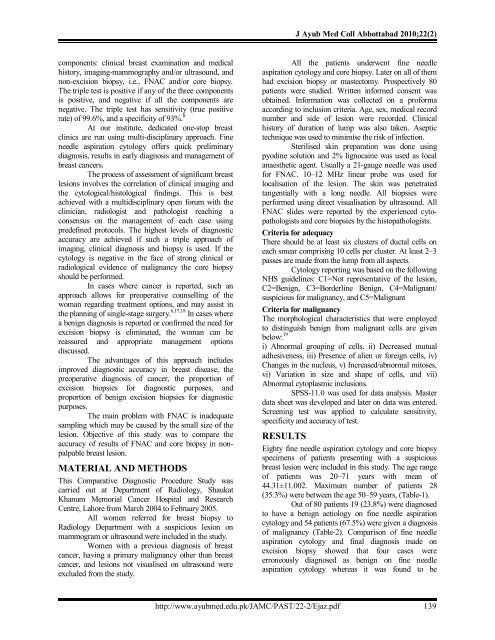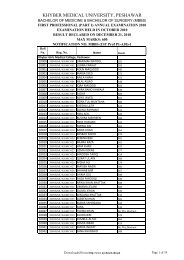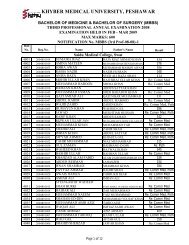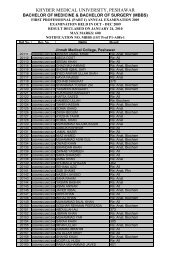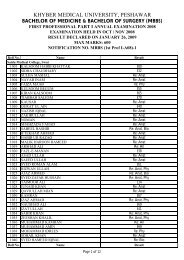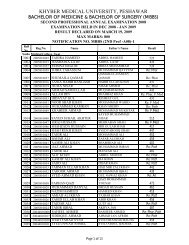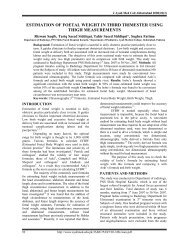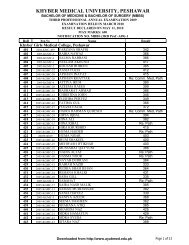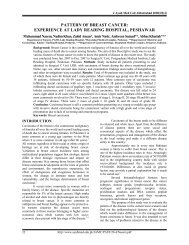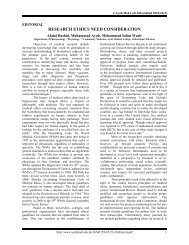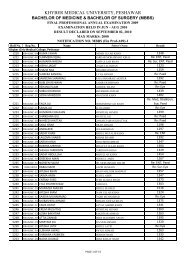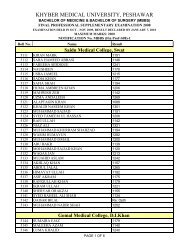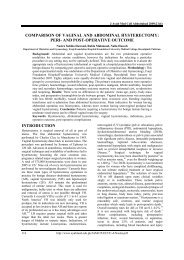ultrasound guided fine needle aspiration cytology versus core
ultrasound guided fine needle aspiration cytology versus core
ultrasound guided fine needle aspiration cytology versus core
You also want an ePaper? Increase the reach of your titles
YUMPU automatically turns print PDFs into web optimized ePapers that Google loves.
J Ayub Med Coll Abbottabad 2010;22(2)<br />
components: clinical breast examination and medical<br />
history, imaging-mammography and/or <strong>ultrasound</strong>, and<br />
non-excision biopsy, i.e., FNAC and/or <strong>core</strong> biopsy.<br />
The triple test is positive if any of the three components<br />
is positive, and negative if all the components are<br />
negative. The triple test has sensitivity (true positive<br />
rate) of 99.6%, and a specificity of 93%. 8<br />
At our institute, dedicated one-stop breast<br />
clinics are run using multi-disciplinary approach. Fine<br />
<strong>needle</strong> <strong>aspiration</strong> <strong>cytology</strong> offers quick preliminary<br />
diagnosis, results in early diagnosis and management of<br />
breast cancers.<br />
The process of assessment of significant breast<br />
lesions involves the correlation of clinical imaging and<br />
the cytological/histological findings. This is best<br />
achieved with a multidisciplinary open forum with the<br />
clinician, radiologist and pathologist reaching a<br />
consensus on the management of each case using<br />
prede<strong>fine</strong>d protocols. The highest levels of diagnostic<br />
accuracy are achieved if such a triple approach of<br />
imaging, clinical diagnosis and biopsy is used. If the<br />
<strong>cytology</strong> is negative in the face of strong clinical or<br />
radiological evidence of malignancy the <strong>core</strong> biopsy<br />
should be performed.<br />
In cases where cancer is reported, such an<br />
approach allows for preoperative counselling of the<br />
woman regarding treatment options, and may assist in<br />
the planning of single-stage surgery. 6,17,18 In cases where<br />
a benign diagnosis is reported or confirmed the need for<br />
excision biopsy is eliminated, the woman can be<br />
reassured and appropriate management options<br />
discussed.<br />
The advantages of this approach includes<br />
improved diagnostic accuracy in breast disease, the<br />
preoperative diagnosis of cancer, the proportion of<br />
excision biopsies for diagnostic purposes, and<br />
proportion of benign excision biopsies for diagnostic<br />
purposes.<br />
The main problem with FNAC is inadequate<br />
sampling which may be caused by the small size of the<br />
lesion. Objective of this study was to compare the<br />
accuracy of results of FNAC and <strong>core</strong> biopsy in nonpalpable<br />
breast lesion.<br />
MATERIAL AND METHODS<br />
This Comparative Diagnostic Procedure Study was<br />
carried out at Department of Radiology, Shaukat<br />
Khanum Memorial Cancer Hospital and Research<br />
Centre, Lahore from March 2004 to February 2005.<br />
All women referred for breast biopsy to<br />
Radiology Department with a suspicious lesion on<br />
mammogram or <strong>ultrasound</strong> were included in the study.<br />
Women with a previous diagnosis of breast<br />
cancer, having a primary malignancy other than breast<br />
cancer, and lesions not visualised on <strong>ultrasound</strong> were<br />
excluded from the study.<br />
All the patients underwent <strong>fine</strong> <strong>needle</strong><br />
<strong>aspiration</strong> <strong>cytology</strong> and <strong>core</strong> biopsy. Later on all of them<br />
had excision biopsy or mastectomy. Prospectively 80<br />
patients were studied. Written informed consent was<br />
obtained. Information was collected on a proforma<br />
according to inclusion criteria. Age, sex, medical record<br />
number and side of lesion were recorded. Clinical<br />
history of duration of lump was also taken. Aseptic<br />
technique was used to minimise the risk of infection.<br />
Sterilised skin preparation was done using<br />
pyodine solution and 2% lignocaine was used as local<br />
anaesthetic agent. Usually a 21-gauge <strong>needle</strong> was used<br />
for FNAC. 10–12 MHz linear probe was used for<br />
localisation of the lesion. The skin was penetrated<br />
tangentially with a long <strong>needle</strong>. All biopsies were<br />
performed using direct visualisation by <strong>ultrasound</strong>. All<br />
FNAC slides were reported by the experienced cytopathologists<br />
and <strong>core</strong> biopsies by the histopathologists.<br />
Criteria for adequacy<br />
There should be at least six clusters of ductal cells on<br />
each smear comprising 10 cells per cluster. At least 2–3<br />
passes are made from the lump from all aspects.<br />
Cytology reporting was based on the following<br />
NHS guidelines: C1=Not representative of the lesion,<br />
C2=Benign, C3=Borderline Benign, C4=Malignant/<br />
suspicious for malignancy, and C5=Malignant<br />
Criteria for malignancy<br />
The morphological characteristics that were employed<br />
to distinguish benign from malignant cells are given<br />
below: 19<br />
i) Abnormal grouping of cells, ii) Decreased mutual<br />
adhesiveness, iii) Presence of alien or foreign cells, iv)<br />
Changes in the nucleus, v) Increased/abnormal mitoses,<br />
vi) Variation in size and shape of cells, and vii)<br />
Abnormal cytoplasmic inclusions.<br />
SPSS-11.0 was used for data analysis. Master<br />
data sheet was developed and later on data was entered.<br />
Screening test was applied to calculate sensitivity,<br />
specificity and accuracy of test.<br />
RESULTS<br />
Eighty <strong>fine</strong> <strong>needle</strong> <strong>aspiration</strong> <strong>cytology</strong> and <strong>core</strong> biopsy<br />
specimens of patients presenting with a suspicious<br />
breast lesion were included in this study. The age range<br />
of patients was 20–71 years with mean of<br />
44.31±11.002. Maximum number of patients 28<br />
(35.3%) were between the age 50–59 years, (Table-1).<br />
Out of 80 patients 19 (23.8%) were diagnosed<br />
to have a benign aetiology on <strong>fine</strong> <strong>needle</strong> <strong>aspiration</strong><br />
<strong>cytology</strong> and 54 patients (67.5%) were given a diagnosis<br />
of malignancy (Table-2). Comparison of <strong>fine</strong> <strong>needle</strong><br />
<strong>aspiration</strong> <strong>cytology</strong> and final diagnosis made on<br />
excision biopsy showed that four cases were<br />
erroneously diagnosed as benign on <strong>fine</strong> <strong>needle</strong><br />
<strong>aspiration</strong> <strong>cytology</strong> whereas it was found to be<br />
http://www.ayubmed.edu.pk/JAMC/PAST/22-2/Ejaz.pdf 139


